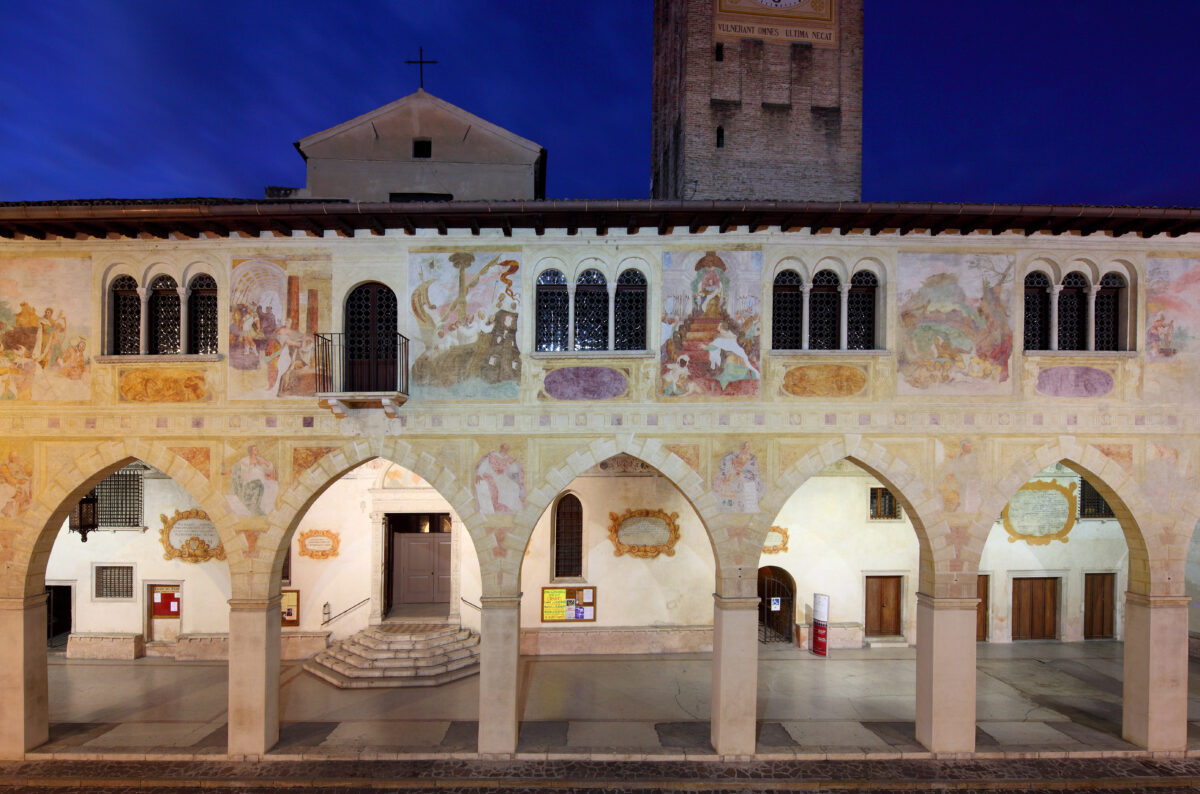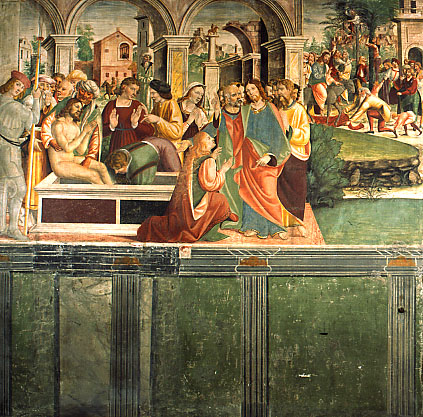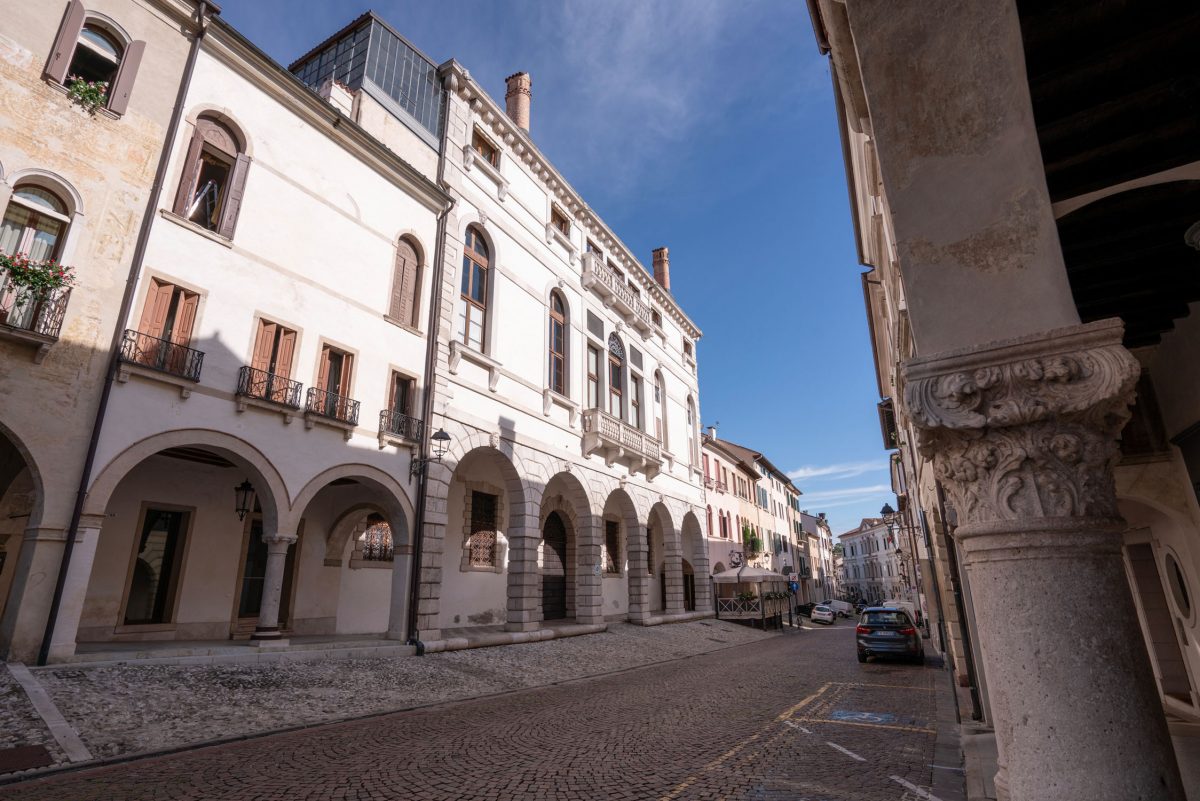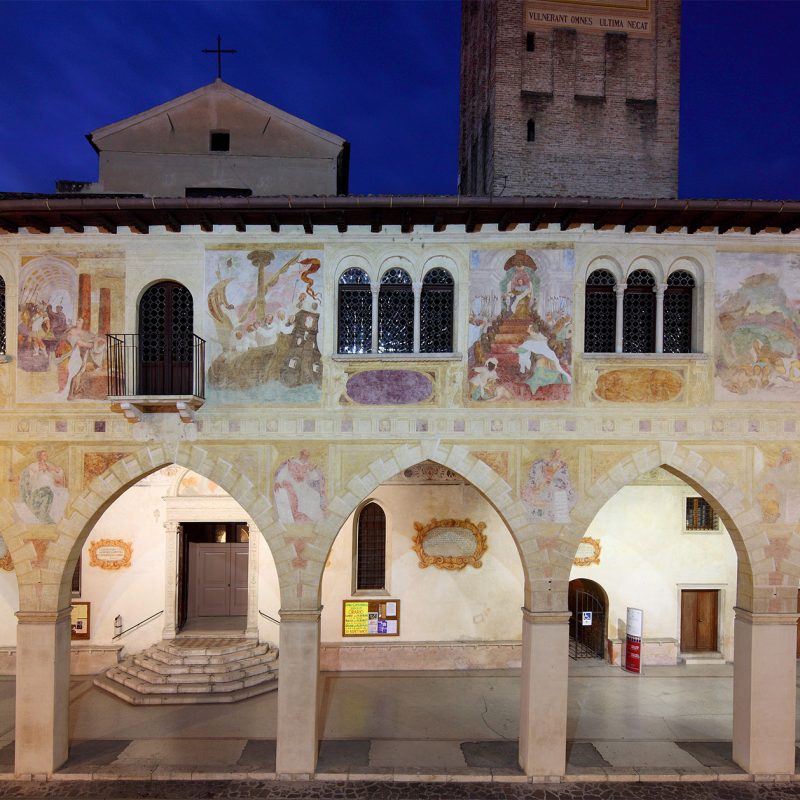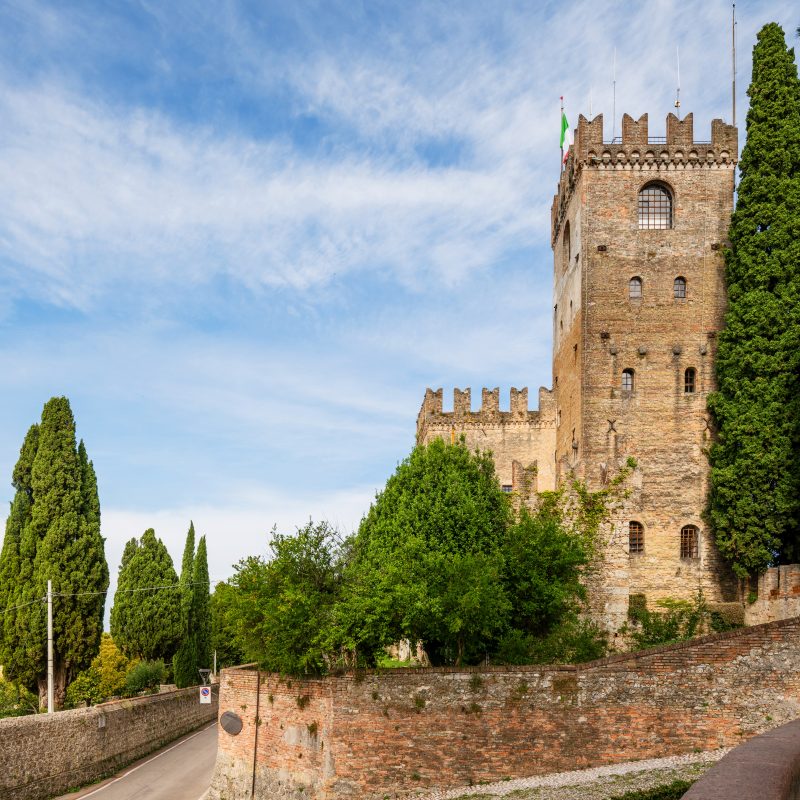Pedestrian path in the historic center of Conegliano – “Conegliano Urbs Picta”

In the Renaissance era Conegliano was the protagonist of an architectural and urban renewal process that reflected the favorable social and economic conditions of the territory, which was subjected to the dominion of the Serenissima and enjoyed the advantages brought by the long Venetian pax, which favored trades and agricultural yields.
During this period there were many new palaces built in the Contrada Grande at the foot of the castle and numerous were the fresco interventions carried out in civil and religious buildings that transformed the town into a true Urbs picta.
Despite the damage caused by time, atmospheric agents and wars, there are still numerous testimonies of Renaissance frescoes in the town that we will try to make you discover along this itinerary that begins on the top of the hill overlooking the town.
Inside the Civic Museum, housed in the Guard Tower, some detached frescoes are exhibited. In this itinerary, we only point out those from the historic center of Conegliano.
On the ground floor, in the Sala Vazzoler, there is a fresco divided into seven panels, which is from the destroyed church of Sant’Antonio Abate di Conegliano that was near the current Piazza Duca d’Aosta. Painted around 1514 by Giovanni de Sacchis known as Pordenone (Pordenone c. 1483 – Ferrara 1539), it depicts the Madonna con Bambino (later made), Santa Caterina e Santo Agostiniano, Santa Maria Maddalena e San Tommaso Becket.
On the upper floors are visible:
– Dario da Treviso, Madonna in trono con Bambino, second half of the 15th century. The fresco comes from a wall of the landing that connected the new Palazzo Montalban, in via XX Settembre in Conegliano, with the women’s gallery of the Oratory of the Madonna della Salute.
– Venetian painter of the first half of the fifteenth century, Madonna con Bambino tra angeli e devoto. Originally, the fresco was located in a house, now destroyed, located on the left of the Duomo di Conegliano; it was part of the hospice for pilgrims built by the Confraternita dei Battuti.
In the large square of the Castle, there is the small church of Sant’Orsola, which preserves traces of the frescoes of the church that, until 1757, was the Collegiate Church of San Leonardo. In fact, among the surviving images, the saint of Limoges is recognizable.
Then, we will go down from the hill through the suggestive Calle Madonna della Neve.
Where once there was Porta della Castagnera, the small church of the Madonna della Neve was built, which gives the street its name. Inside, you can admire a fresco painted in two different moments: in the center, there is La Madonna del latte. Its realization – datable shortly after the half of the fifteenth century – was attributed to Giovanni Antonio da Meschio; while the musician angels and those who hold the thurible and the incense boat were added in the sixteenth century by the painter Francesco Beccaruzzi from Conegliano.
At the end of the calle, we will turn right into via Edmondo De Amicis. At civic number 3, in what is now a private home, there was the ancient Seat of the Confraternita della Beata Concezione. In what used to be the meeting room, there are frescoes depicting San Rocco, un santo vescovo, la Vergine con il Bambino, Sant’Anna, San Sebastiano e San Francesco presenting the church; these were probably made at the beginning of the sixteenth century by Francesco Pagani, known as da Milano.
A little further on, on the right, there is the stairway that leads to the former Convent of San Francesco.
During the restorations carried out in the early 2000s, decorative fresco elements came to light both in the walls of the sixteenth-century cloister and in the rooms used by the Inquisition Tribunal. Besides, in the room used as a guesthouse, a plump San Francesco who welcomes visitors with open arms can be admired; in the adjoining room, a fragment of a fresco has reappeared, depicting San Bonaventura da Bagnoregio, considered one of the most important biographers of San Francesco d’Assisi.
Now we will go down the ladder that leads us to via Beccaruzzi, named after the Renaissance painter who lived here. The Alpini of Conegliano occupy the house now.
Arrived at the little square, we will turn left into via Cima, which overlooks one of the first frescoed houses in Conegliano. You can recognize it on your right from the “regalzier“, the decorative red brick element that began to be used in the Venetian territory from the second half of the fourteenth century. However, the layout of the building and the phytomorphic plant elements that decorate the band under the roof lead us to date the fresco to the 15th century.
We will continue to walk along the street that in the Late Middle Ages was inhabited by families belonging to the small bourgeoisie: artisans, traders… After passing Casa Cima, where the famous Renaissance painter Giovanni Battista Cima lived (Conegliano, 1459/1460 – around 1517), whose family produced fabrics, we will stop in front of the house on our left, which has traces of frescoes on the façade. The restorations, carried out a few years ago, in fact, brought to light – under different layers of plaster – phytomorphic elements arranged in a lozenge and, in the upper part, a coat-of-arms where there is a “romano” in the center, that is the unit of weight used in steelyard. The functioning of that scale is based on the principle of levers, a probable allusion to the profession exercised by the inhabitants of the house.
At the end of the street, at the corner with Via Accademia, we will find Casa Sbarra, probably built in two phases from the end of the 15th century. Its façade was once completely covered with frescoes: those protected by the projection of the roof are still clearly legible today. The author could be Dario da Treviso (about 1420 – Conegliano, before 1498), whose high abilities are retained in our territory through many testimonies. However, the decorative band of the attic could be the result made by another hand, identified as Girolamo Pennacchi (see Giuliano Martin, Conegliano affrescata, Vianello Libri, 1989).
Under the portico, you can admire a Sacred Conversation and a Crucifixion. Their attribution is still being discussed.
At this point, we will go down to via XX Settembre, the ancient Contrada Grande, and we will turn right: the second building that we will find is the medieval Casa Biffis. Of all the frescoes that originally decorated the entire façade, today only the band under the cornice is legible, which shows elements taken from the classical repertoire.
A little further on, the current town cathedral overlooks the street; the original church and the meeting room above were, however, built by the Confraternita dei Battuti in the 14th century.
Many frescoed works have been preserved in this complex: from the decorative elements of the late fifteenth century in the naves, to the images of San Lorenzo and Santo Stefano painted on the pillars inside the church; from the lunette depicting La Vergine tra i Battuti above the entrance door, to the decorative elements in the portico. However, there are two cycles of greatest value, both created to decorate the overlying Sala dei Battuti:
– The façade represents the largest wall fresco in Veneto. It was painted at the end of the 16th century by Ludovico Toeput known as il Pozzoserrato, a Flemish painter, who worked in Venice with Tintoretto, stayed in Rome, and then settled in the Treviso area where he created important works of art. On this façade, above the Sibyls and the Prophets painted in the sails between the arches, he created scenes from biblical episodes. In the center, he placed the representation of the Battuti, who, invoking the Virgin, save a ship at the mercy of the storm, a clear allusion to heresies that undermined the existence of the Church at that time.
– The interior of the Hall was instead frescoed by Francesco da Milano with a cycle depicting the story of Christ, from his birth to the Last Judgment. The demolition of a wall to expand the environment required the subsequent intervention of Pozzoserrato, who created the scenes of Creazione del mondo, Creazione di Adamo ed Eva and Il peccato originale, while L’Annunciazione, La Visitazione and La Natività, painted on the minor side of the room, are probably works of collaborators.
A little further on, still on via XX Settembre, but on the other side of the street, there is Palazzo Graziani, now Bidasio Zoppas. Its recent restoration has brought to light the frescoes with decorative elements, a pastoral scene and a female figure in a red background, made between the end of the 15th and the beginning of the 16th century.
Now retracing our steps, at the corner with Piazzetta XVIII Luglio 1866, we will be able to admire Casa Dalla Balla now Piutti, decorated with sixteenth-century frescoes depicting decorative elements and characters with caricatural features.
After passing Piazza Cima and Via Sbarra – overlooked by the former fire brigade building, in which there are fifteenth-century wall decorations that probably refined what was originally the ancient municipal building – we will find ourselves surrounded by frescoed houses: on our left Palazzo Grimani Vettori, which shows off the cardinal’s galero and the coat-of-arms of the Grimani family in the upper part, while in the lower bands polychrome and monochrome scenes have recently re-emerged, including La Lupa con Romolo e Remo, an appropriate subject for this important Venetian family that had vast properties and political connections in Rome; on our right Casa Colussi, former seat of the Knights of the Podestà, which still has important traces of the fresco decoration that once covered the façade with allegorical scenes, floral compartments and festoons. Recent restorations have brought to light frescoes also in the interiors.
Under the portico you can admire a fresco with an unusual iconography: on the same large marble throne with Renaissance-style decorative elements a severe Vergine con il Bambino sits on the right and Il Padreterno che regge il crocifisso on the left.
A little further on, on the left we will find Palazzo Sarcinelli, which has sixteenth-century frescoes in the entrance hall, in the counter-façade and in the noble floor. Some of these are attributed to Riccardo Peruccolo (Zoppè, between 1515 and 1520 – Conegliano, 1568), an unfortunate local artist condemned to the stake because considered a heretic.
On the opposite side of the street there are other buildings decorated with frescoes, testimonies of the ancient Urbs picta; in fact, the images of a young woman reading, of a knight and Adamo ed Eva are still clearly visible.
A little further on, on the left side of the street there is the ancient Monte di Pietà, frescoed in 1525 by Ludovico Fiumicelli (1500 ca – 1582) with Pietà e Angeli reggenti gli strumenti della passione.
The street – and our itinerary – end with Porta Monticano or del Leone, so named for the image frescoed by Pordenone in the batti ponte niche.
Useful information
Image gallery
 Add to your itinerary
Add to your itinerary


